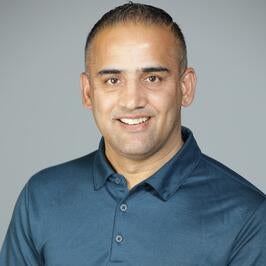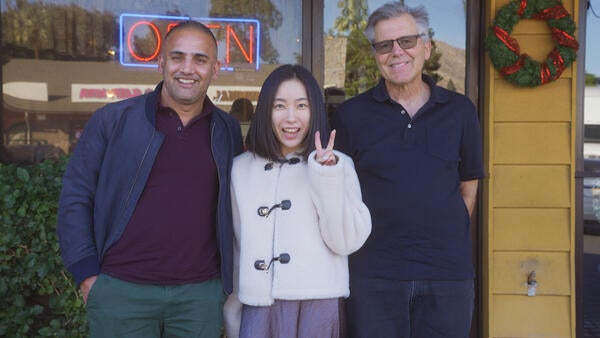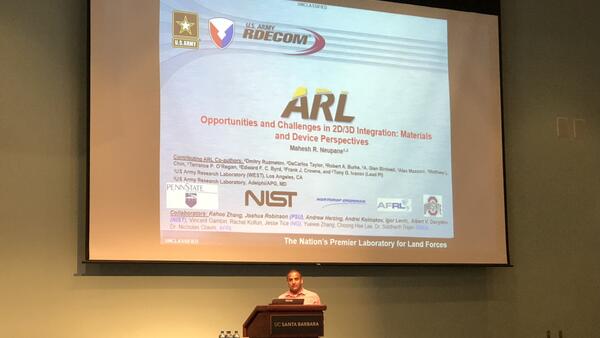
The text Mahesh Neupane received simply said, “Congratulations.”
The assistant adjunct professor at the Marlan and Rosemary Bourns College of Engineering (BCOE) and research program manager for the Army Research Office (ARO) at the United States Army Combat Capabilities Development Command Army Research Laboratory (DEVCOM ARL) didn’t know what to make of it.
“I Googled my name,” he said. “Nothing came up.”
The note had come from a colleague, and Neupane — also a BCOE alum — buckled into a plane seat next to his supervisor, found himself stumped.
Half an hour later, the colleague’s voice filled the phone line: Neupane (PhD, Electrical Engineering, ’15) had received a Presidential Early Career Award for Scientists and Engineers (PECASE) — the highest honor the U.S. government confers on outstanding early-career scientists and engineers.
And there’s more.
That same day, Neupane also learned about an internal announcement honoring him with DEVCOM’s 2024 Modeling and Simulation Award in the individual research category for analysis. He was recognized for his contribution to “Quantum Mechanics-based Multiscale Modeling of Multiphase Polar Heterostructure for RF Electronics.”
“A good day, I would say,” the researcher deadpanned.
This recent recognition reflects Neupane’s exceptional track record in a demanding field: He helps advance national security by conceiving, designing and modeling future technologies for the U.S. Army.
***
Neupane uses multiscale modeling schemes combining quantum and classical mechanics to conceptually engineer lighter, smaller, less power-hungry electronics: transistors and semiconductors for use in areas such as communications, detections and sensing. These designs must survive in high heat, high pressure, and other extreme environments — not today or next year, but in 2045 and beyond.
“We’re looking for technology that will be relevant in 20 years’ time,” Neupane said. “I discover new electronic phenomena in solid-state matter and exploit it for unforeseen technological opportunities.”
He does this through predictive modeling; creating models and experimental scenarios that test a range of designs and materials in a simulated environment.
At BCOE, a small group of graduate students, in cooperation with faculty, helps advance the research, which in turn is relayed to the internal research group at ARL.
“We envision models and test them in a simulation environment,” Neupane said. “Once we are satisfied with the properties and the features from the simulations, I hand it to my experimentalist colleague to try in the lab.”
His predictive models not only seed innovation, but also save time and money by preventing failures later in prototype testing.
***
Neupane’s career goals formed early, thanks to curiosity, a love of fixing things, and a civil-engineer neighbor, whom he called uncle, in Nepalgunj, Nepal.
As a child, Neupane was riveted by how things were made and assembled — how they moved and worked and flew.
“To this date, I am still driven by discovery and finding novel things around me in the field, by the novel aspects of technology,” he said. “What is the underlying physics that drives things around us?”
To pursue his dream, he moved to the United States in 2003, earning a master’s degree in computer science at California State University, San Bernardino. He went on to earn another master’s degree and a PhD, both in electrical engineering, at BCOE.
“I've always wanted to be an engineer and contribute to the field, ” he said. “I didn't only dream about it; I worked hard to make it a reality.”
Neupane’s contributions to the field have been recognized over the years. He received a 2016 ARL Science Award, a 2020 Sensors and Electron Devices Directorate Diversity Award, a 2022 ARL Early Career Award, and he was named a 2022 Office of the Secretary of Defense’s Laboratory-University Collaboration Initiative Fellow.
This past January, Neupane was notified that he had been named the recipient of the PECASE — one of only three faculty from UC Riverside to receive this award.
***
Today, Neupane’s workdays include not just computer modeling but also hours of reading, research, learning, mentoring, and consulting with experts outside of his field for ideas, knowledge, and inspiration for his craft.
He is driven by purpose: to advance science, enhance national security and volunteer to nurture young engineers and scientists.
To this end, he teaches in BCOE’s Department of Electrical and Computer Engineering and Materials Science and Engineering program. Over the past six or seven years, he said, he has helped five graduate students earn PhDs in his field. Most of them are now employed by leading technology companies and research laboratories.
By necessity, Neupane models the ability to clearly distinguish the best option among competing ones: Experimental future technologies tend to fail, with just 5 to 10 percent of ideas proving viable. He thinks failure is success if we learn from it.
His advice for students?
“One thing you can control is your time,” Neupane said. “It’s up to you how you manage your time. You can relax and chill, or you can contribute to making discoveries for the future.”
***
At times, pursuing discoveries on computers can leave Neupane with a sense of disconnection. He credits his teenage son, Nibodh, and his wife, Pratima, a social worker who aids foster children, with keeping him grounded.
“When you are involved with abstract concepts to solve future problems, you can lose connections with human beings,” Neupane said.
He also finds cooking therapeutic (chicken curry is a favorite) and enjoys basketball and soccer.
Most of all, he appreciates family. Neupane praised his elder brother, Suresh, a journalist in Nepal who also dreamed of becoming an engineer.
“He’s the supporting force behind whatever I’ve achieved so far, along with my wife, son and my parents,” he said. “He made a lot of sacrifices for me when we were young. To this day, he is very proud of what I have done. It feels like I have achieved his dream.”
Header Image: Mahesh Neupane presenting at the 76th Device Research Conference, which brings together scientists, researchers, and students to share their latest findings in device science, technology, and modeling. (Photo courtesy of U.S. Army)


